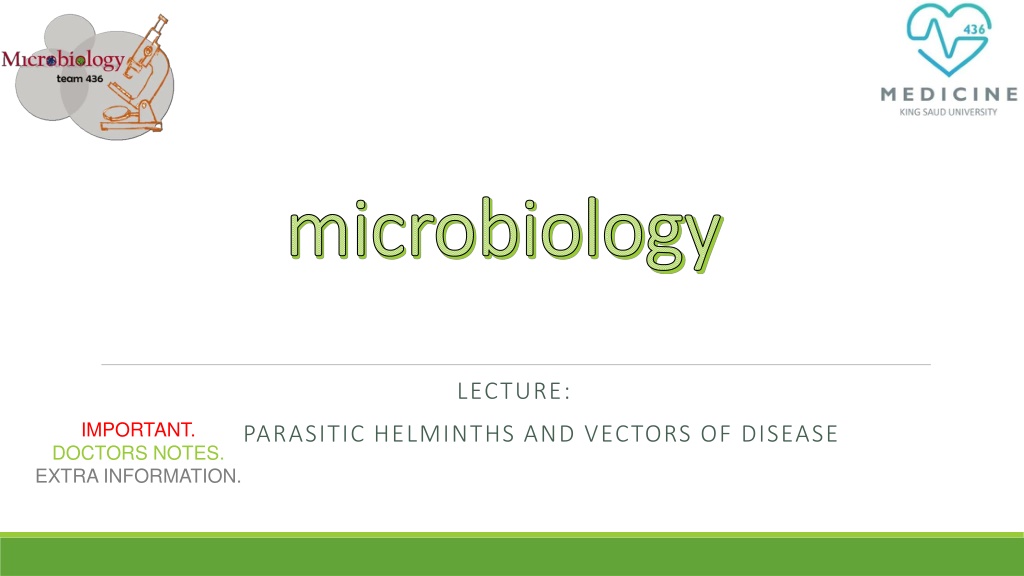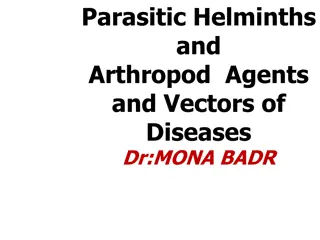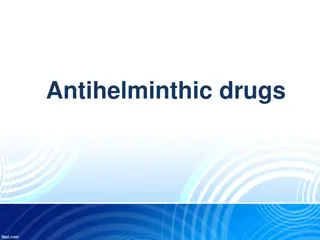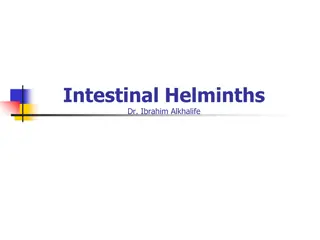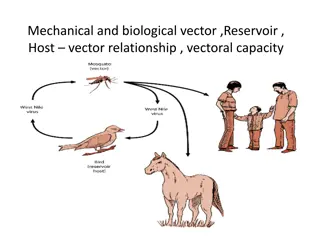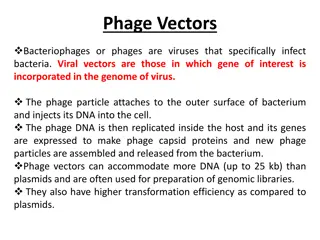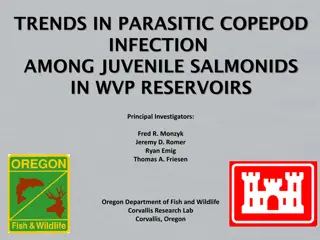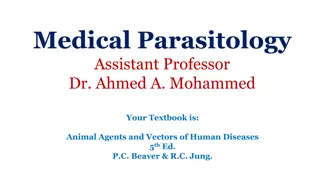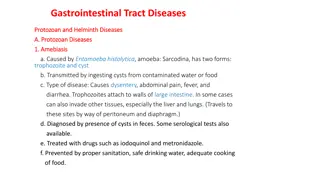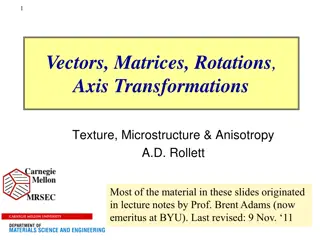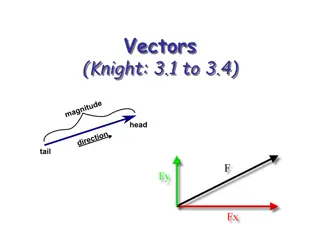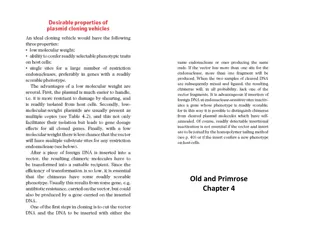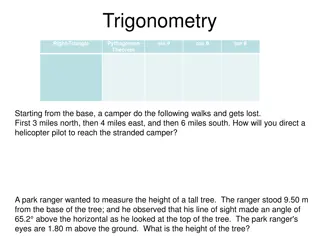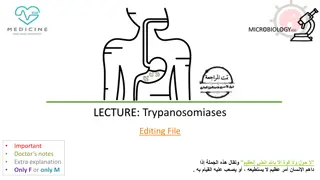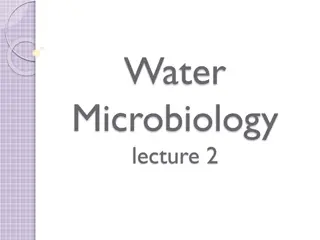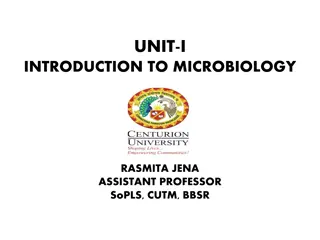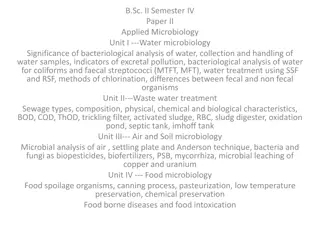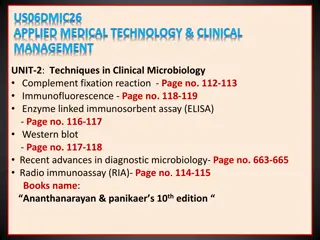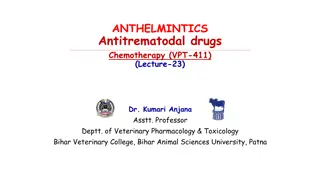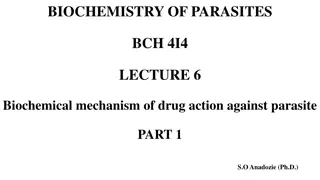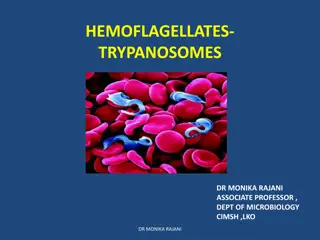Understanding Parasitic Helminths and Disease Vectors in Microbiology
Explore the world of parasitic helminths and disease vectors in microbiology. Learn about the classification of parasites, the life cycle of Ascaris lumbricoides, and the role of arthropods as agents and vectors of diseases in humans. Discover the characteristics of the three main groups of parasitic helminths and their locations in the body. Dive into the details of nematodes, specifically Ascaris lumbricoides, and understand how it infects humans and completes its life cycle. Gain insights into the important aspects of these parasitic organisms in causing infections and diseases.
Download Presentation

Please find below an Image/Link to download the presentation.
The content on the website is provided AS IS for your information and personal use only. It may not be sold, licensed, or shared on other websites without obtaining consent from the author. Download presentation by click this link. If you encounter any issues during the download, it is possible that the publisher has removed the file from their server.
E N D
Presentation Transcript
microbiology microbiology LECTURE: IMPORTANT. DOCTORS NOTES. EXTRA INFORMATION. PARASITIC HELMINTHS AND VECTORS OF DISEASE
Objective: Name the three main groups of parasitic helminths and their characteristic morphological features . 3-4 Describe the life cycle of Ascaris lumbricoides as an example of parasitic helminths . 6-7 Discuss the role of arthropods as agents and as vectors of diseases in humans. 14-16 Give examples of the main arthropod vectors of diseases. 14-16
Classification of Parasites Protozoa Helminthes Unicellular Single cell for all function Mulicellular Specialized cells A- Round worms = Nematodes cylindrical , un-segmented (Ascaris) B- Flat worms 1-Trematodes: leaf-like, un-segmented. -Amoebae: move by pseudopodia. -Flagellates: move by flagella. -Ciliates : move by cilia -Apicomplexia (sporozoa) Tissue parasites 2-Cestodes: tape-like, segmented
Location of helminths in the body: Intestinalhelminthes: Tissue helminthes:
Nematodes (round worm) intestinal Nematode: General features Male is shorter than female 1. Elongated worm, cylindrical, unsegmented and tapering at both ends ) . ( 2. Variable in size, measure <1cm to about 100cm. 3. Sex separate and male is smaller than female Example: Ascaris lumbricoides (roundworm) -The commonest intestinal helminthes can cause infection to human. -Found in jejunum and upper part of ileum. -Female ( 20-40cm) which is longer than male ( 10-15 cm) . -Feed on semi digested food. ) ( Can cause malnutrition
Ascaris lumbricoides life cycle It infect the human when man ingest an fertilized egg contaminated with food or water then this fertilized egg become a Larva that penetrate the wall of the duodenum and enter the blood stream to the heart , liver and enter the pulmonary circulation and stay in the alveoli ,where it grow and molts for three weeks then Larva passes from respiratory system to be coughed up ,swallowed ,returned to the small intestine where it mature to adults male &female unfertilized egg will die Important fertilization take place producing eggs which pass in stool
a Human : definitive host (primary) - - sexual Diagnostic stage is both fertilized egg and unfertilized
Pathogenicity Migrating LARVA Adult WORM The worm consumes proteins and vitamins Ascaris pneumonia , some times from host s diet and leads to malnutrition. LARVA reach aberrant sites like brain Can cause intussusception, intestinal ,heart or spinal cord can cause ulcers and in massive infection can cause unusual disturbance. intestinal obstruction.
flat warm : 1-Tremadotes leaf-like un-segmented. 2-Cestodes tape-like segmented fasciola hepatica Taenia saginata
Taenia saginata fasciola hepatica
MEDICAL IMPORTANCE OF ARTHROPODS 1)As etiologic agents (causes) of diseases. Tissue damage Scabies Induction of hypersensitivity reactions. Injection of poisons Scorpions. Entomophobia (acarophobia) phobia 2) As vectors of diseases: II: Biological transmission: 1- Cyclical: cyclical change only but does not multiply in the body of the vector e.g. :filarial parasite. 2- Propagative: when the disease agent undergo no cyclical change but multiplies in the vector e.g.: plaque bacillie in rat fleas. 3- Cyclo-propagative: the disease agent undergoes cyclical change and multiply in the body of arthropods e.g.: Malaria in mosquito :p 2 I: Mechanical transmission - simple carriage of pathogens e.g.: flies 1 III: Transovarian transmission: transmitted as vector from arthropods parents to offspring as ricketsis carried within ticks. 3
Scabies as tissue damage example of Arthropod As etiologic agents (causes) of diseases.
ARTHROPODS OF MEDICAL IMPORTANCE Class Insecta Class Arachnida Class Crustacea 1. Muscid flies:- Housefly,Tsetse fly 2. Myiasis-producing flies . 1. Water flea: - Cyclops. 1. Spiders: 2. Scorpions 3. Mosquitoes: - Anopheles, Aedes Culex 3. Ticks: hard, soft 4. Mites: 4. Sandfly: - (Phlebotomus) - Dust mites - Sarcoptes scabiei, 5. Black fly (Simulium) 6- Fleas 7. Lice: - Pediculus, Phthirus. 8. Bugs: - Cimex, Triatoma. 9. Bees:
Important arthropod vectors for human diseases Important arthropod vectors for Transmitter Disease Mechanical transmission of many viruses, bacteria and parasites. House fly (Musca domestica) Mosquitoes - Anopheles: malaria, filariasis - Culex: filariasis, viruses - Aedes: yellow fever, dengue fever, Rift Valley Fever human diseases Lice Body louse: vector for Relapsing fever, typhus and trench fever. Fleas Rat flea: is vector for plague due to Yersinia pestis. Ticks Soft ticks: some are vectors for: Borrela duttoni Hard ticks Include vectors for Babesiosis (protozoa), Q fever and Rocky mountain spotted fever Tse tse fly (Glossina) Vector for African Trypanosomiasis (African sleeping sickness) Black fly (Simulium) Vector for Onchocerca (river blindness) Sand fly (Phlebotomus) Vectors for Leishmania and sandfly fever virus. Cyclops Vector for Dracunculus medinensis
Important arthropod vectors for human diseases Louse (singular) , Lice (pleural) Pediculus humanus Sand flay transmit leishmania Image result for lice
Important arthropod vectors for human diseases Image result for Mosquitoes Mosquitoes: Cosmopolitan , more than 3000 species. Larval and pupal stages always aquatic Mouth parts in female adapted to piercing and sucking blood. Genus and species distinguished by morphology of adult and developmental stages. Image result for youtube logo Mosquitoes Cyclo-propagative Always know more ;) Malaria
Summary quiz https://www.onlineexambuilder.com/microbiology-l12/exam-109227
Contact us : THE TEAM : THE TEAM : 436microbiologyteam@gmail.com Waleed Aljamal Ibrahim Fetyani Meshal Eiaidi Khalid Alhusainan Hussam Alkhathlan Faisal Alqumaizi Shrooq Alsomali Hanin Bashaikh Jawaher Alkhayyal Reem Alshathri Rawan Alqahtani Ohoud Abdullah Ghadah Almazrou Lama Al-musallam Twitter : @microbio436
